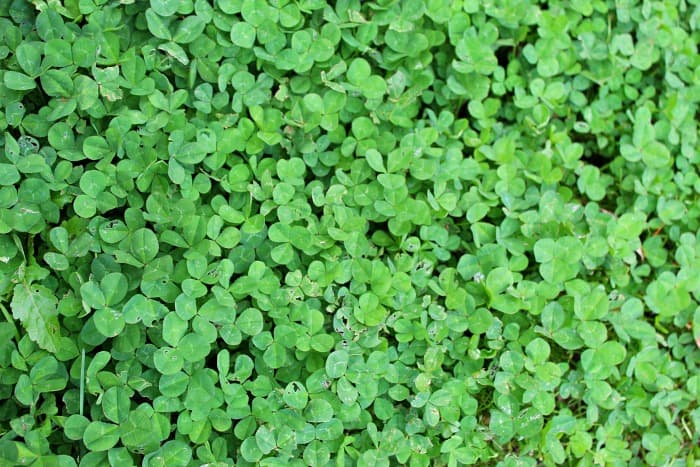Clover can be one of the hardest lawn weeds to control. But with the right strategy, and products, you can kill clover and prevent it from coming back.
Clover is a low growing, quick spreading, perennial plant with three leaves and white or pinkish flowers. Clover is one of the most common lawn weeds and also one of the toughest to control. It’s aggressive spreading habit allows one small plant to multiply in size.
Clover also has the unique ability to create its own nitrogen which makes it thrive in an underfed lawn.
Most varieties, such as white clover, are perennial, so you can count on it coming back every year as you leave it unchecked. It also self seeds and can pop up in sections of your landscape that have been clover free in the past.
Clover Life Cycle
After spending the winter in a dormant state (except for warmer regions where it can stay active during the winter), clover begins to wake back up and spread when soil temps approach 50 degrees. White clover, which is one of the most popular lawn weeds, will flower from early spring- summer and spread aggressively if not controlled. Eventually the flowers turn to seeds and these seeds germinate in early fall.
Kill Clover with Lawn Safe Liquid Weed Killer
The best way to kill clover is by using a lawn safe, liquid weed killer:
For Cool Season Lawns:
1. Ortho Weed B Gone Chickweed, Clover, Oxalis Killer– This is a great product for targeting clover, chickweed, and oxalis which can be some stubborn weeds to control. It also controls a number of other common lawn weeds in cool season lawns. It is sold as a concentrate so will require mixing with a tank sprayer.
2. Ortho Weed B Gone Plus Crabgrass Control– This is a great product to always have on hand if you have cool season grass since it controls such a large variety of lawn weeds, including crabgrass. This product is available in a pre mixed ready to use formula that has an applicator wand, or you can buy the concentrate that gets mixed with water in a tank sprayer.
3. Tenacity– Tenacity (active ingredient Mesotrione) is another great liquid weed killer that will kill clover. It is the ideal choice if you are getting ready to seed your lawn since it’s one of the few herbicides that won’t interfere with seed germination of cool season lawn varieties. In fact it can even be applied at the same time as seeding. So if you’re planning on doing any type of seeding and you also want to solve your clover problem, then Tenacity should be your go to choice.
For Warm Season Grasses:
1. Celsius WG– Celsius WG is a great all around lawn safe liquid weed killer that kills a large number of broadleaf weeds as well as grassy weeds. It does a great job killing a variety of clovers. Best of all this is safe to use in most warm season grass types such as Bermuda, St. Augustine, Zoysia, and Centipede.
2. Image Southern Lawn Weed Killer– This is another great all around lawn safe liquid herbicide that kills a number of broadleaf weeds, including clover. This is actually the go to liquid weed killer I recommend in my lawn care program for warm season grass. Even though the front label says its safe on St. Augustine and Centipede, if you look at the back it says it’s also good for Bermuda, Zoysia, and Bahia.
*** Pro Tip– Repeat applications will likely be necessary when using any of the above weed killers. Also, mixing in a little surfactant with the herbicide will help the herbicide stick to the plant. Always follow label instructions when applying herbicides.
Pre Emergent Herbicides
While pre-emergents won’t kill existing clover, or prevent it from spreading, it will prevent new clover seeds from germinating. Pre-emergent herbicides are an important part of any lawn care program and help to prevent a large variety of broad leaf weeds from emerging. The trick to a good pre-emergent plan is correctly timing your applications based on soil temperatures.
Get Rid of Clover Without Chemicals
Manual removal of clover in your lawn can be very difficult since its roots are well spread and anchored in the soil. Using a weed puller tool will make it easier if clumps are small.
A better option for a chemical free way to kill clover is to use vinegar. Mix vinegar with water (usually a 1:1 ratio) and spray it directly onto the clover. Be careful not to overspray, as vinegar can also harm surrounding plants and grass.
A Healthy Lawn Is the Best Defense
A healthy, well maintained lawn is always the best defense against clover. When you have bare spots in your lawn, it is the weeds that will claim the real estate. Stick to a simple lawn care program to keep your existing turf lush.
Check Out These Posts Next
How to Kill Weeds Without Killing Grass
Follow Me
Join my free email list!



Are any of these products harmful to dogs? If so how long a period after use to wait for dog to enter yard? I have a lot of clover specific to mostly one area but spotty throughout my backyard. Large yard! Is this time of year, April, good to apply?
this time of year is definitely a great time to apply! The recommended products mention they are typically pets safe once the product has dried. Just make sure they aren’t around during spraying or right after. Dogs that do ingest the chemicals when still wet can experience vomiting and stomach ache but usually nothing more serious. I like to play things safe and keep my dog away for a full day if possible. You could always do the front yard one day and the back the next so the dog has somewhere to go out!
I need some help on what I could use to get rid of Bermuda without killing my bluegrass and fescue. The Bermuda I have had a long tap root and spreads out with a long shoot with roots about every one to two inches.
Hi Mike! That’s a common question… Look up a product called Ornamec Over the Top. It is great for controlling Bermuda Grass in your cool season lawn without harming the lawn.
We applied tenacity 19 days ago to combat clover, bentgrass, chickweed, and sedge. Nothing is completely dead yet, just white. Our main issue is clover which has barely turned white. Do you recommend a 2nd application of tenacity tank mixed with triclopyr/ortho weed b gone?
We are trying to knock out the weeds and overseer before it gets too hot here in zone 7a.
That white is exactly what you want to see at this point! It is definitely working but I always recommend a follow up treatment. The other thing I would recommend is mixing in some Surfactant which helps the herbicides stick to the leaves. If you’re looking to overseed I would stick to just Tenacity since that is the safest herbicide to use leading up to an overseeding project. Definitely do the follow up treatment and you can pretty much overseed at the same time. Let the new grass get established and then continue spot treating throughout the year. It’s definitely a process but eventually you’ll win the battle.
It’s currently October with highs in the 50s and lows in the upper 30s. Our church lawn has a ton of clover in it and was wondering if I should treat now or wait until spring? Thanks for your help.
Hi Dave. With those temperatures I’d hold off until spring. Post emergent herbicides become less effective as plant growth slows.
Hi Mark! We are in zone 7b in SC and soil temps are avg 37degrees now. We have a fescue lawn, with large patches of clover now. Should we treat with the ortho weed be gone concentrate for chickweed, clover & oxialis now or when or what soil temp should we treat it?
HI Kim! Great question because it’s kind of a tough call. This herbicide, like most post emergent herbicides work by moving through the cells of the plant. That’s why weeds need to be actively growing for post emergent herbicides to grow. When they are dormant the cells are not active and therefor the herbicide wont work. Now, if your clover is still green and is actively growing, post emergent herbicides could still work but it won’t be as effective as when your weeds (and lawn) are really in a growth spurt. This is when soil temps are closer to the 50’s. You’re kind of on the border of dormancy which means that cellular activity is very slow, or barely active. If you’re trying to watch your wallet and get the best bang for your buck I would wait until soil temps are at least in the mid 40’s. With clover, it might take 1 or 2 follow up treatments to really knock it out.
Thank you! We will be patient til then, and get after it big time when it warms up a little more.
sounds like a good plan, good luck!
Would it be better to put a pre emergent down and then spot treat the clover or vice versa? Spring here and not sure how long I need to wait between the treatments if at all and/or if the order matters. Thanks!
put pre emergent down once your soil temps average 50 degrees for 24 hours in early spring. I use Green Cast Online to check soil temps. For clover, start spot spraying when you see it green in growing. Here in NH that time is now. Don’t forget, clover is a perennial. Pre emergents will only block new seed from germinating, it will not prevent last years clover from coming back. That can only be done with the liquid herbicide you spot spray with.
Thank you! So sounds like pre emergent now since the soil temp is right and then spot treat the clover? Wanted to make sure it wouldn’t be more effective if I treated the clover before putting the pre emergent down.
Will tenacity kill wild strawberries and ground ivy?
Tenacity will kill ground ivy but it’s not labeled for wild strawberries. You can use Ortho Weed B Bone for both wild strawberries and ground Ivy, so that would be my recommendation.